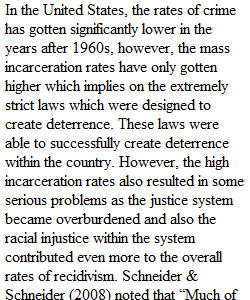


Q Background: In this module, you learned about the 'Carceral States of America'. Many of the effects and causes of these systems overlap. For this discussion, you may utilize material relating to any systems of confinement, but the example offered in your prompt is specifically related to criminal incarceration. Below, you will see a chart from a U.S. Department of Corrections website. It simplistically details the "cycle of recidivism" and offers the state's proposed solution to "breaking the cycle" in effort to reduce the incarcerated population. Prompt: In this discussion, we will be thinking about what goes on "under the hood"—that is: What problems drive and reinforce the "cycle" of mass incarceration or detention? This will be a critical thinking exercise. You have been provided with ample concerns in need of addressing if America is to lose its #1 spot as the country with the highest incarceration rates in the world. The chart below, "Breaking the Cycle of Recidivism" shows a very simplistic model that doesn't capture the complexity that you all are now aware of. It implies that, to break the cycle of recidivism - or the tendency for repeating offenses - a criminal need only leave a "correctional facility" and enter into a "reentry program" in order to become a "productive community member." NOTE: 'Reentry programs' means "community supervision" (e.g., probation or parole, half-way housing, etc.) which may also include mandatory supervised outpatient rehabilitation programs or classes. Post: 1) Consider what you learned in Module 14 (and in previous models) and apply it to the chart shown above. 2) Talk about the human impact of the criminal justice or immigration/detention complex and problematize some point in the chart. You may choose to address how factors of race, class, gender, policing and surveillance, employment, health, community connections, social relationships, cultural perceptions of criminals, etc. make the model problematic or ineffective. Essentially, your task is to incorporate what you've learned into a critique—what nuances are being omitted from this model that perpetuate incarceration, recidivism, or detention? You may put yourself in the shoes of individuals who have experienced confinement, or think at the community level to start. The point that you identify may fall somewhere between the labels also (i.e., somewhere along the red arrows)- remember, this model is simplistic! 3) Talk about incarceration as a social institution and what ideologies and/or policies shape American systems of confinement. Response: For your response comments, think about possible solutions. You may also critique the original comment, add to it, or provide a parallel to other concepts within this module or previous modules. Guidelines for discussion boards The general guideline is, for each discussion, you will be expected to post one short (150 - 200 words) but substantial paragraph, and respond to (at least) two of your classmates’ posts with a substantial response (100-150 words). If you ONLY submit your post, then your maximum discussion grade will be 60% (D). If you respond to one other person's post, then your maximum discussion grade will be 70% (C). If you follow instructions and respond to two of your classmates' posts, your discussion grade will be raised from anywhere between 80% (B) to 100% (A). By substantial we mean that you say more than just “I agree” or “great point”. You must explain yourself by referring back to the corresponding topic. NOTE ABOUT DISCUSSIONS: You must submit original work - do not copy others' ideas and present them as your own. Give credit where credit is due. Discussions are NOT political/religious platforms. They are designed to demonstrate that you understand and can clearly and effectively articulate anthropological concepts and facts as they pertain to American Culture and Society. You may certainly incorporate outside reading material or anecdotal information provided it is relevant to the Topic. Only relay personal beliefs or opinions if prompted by assignment instructions.
View Related Questions